Decarbonising Estates - University of Cambridge
Exploring the challenges and opportunities of decarbonising one of the oldest and most varied educational estates in the world
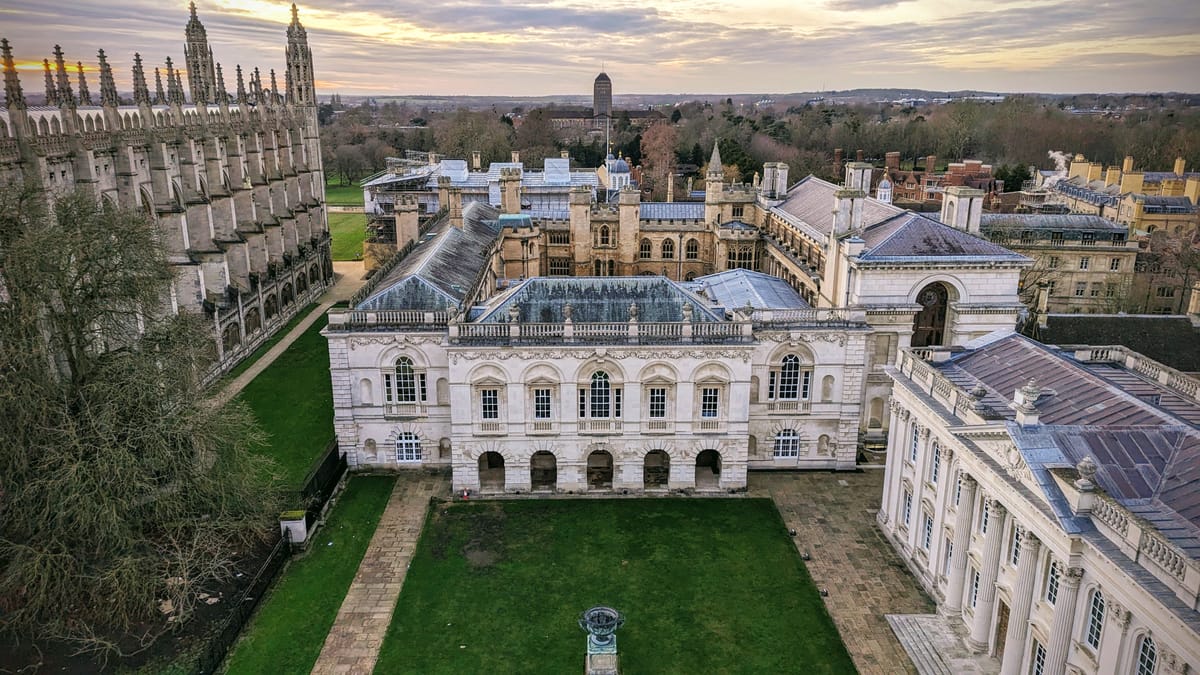
Introduction
The decarbonisation of heating and cooling of university estates in the UK presents a unique opportunity for institutions to demonstrate commitment to their climate pledges, attract climate-conscious students and reduce their environmental impact. However, significant challenges arise in the diversity of building age, construction type, use-case and internal mechanical and electrical systems.
This article outlines some of the considerations, opportunities and risks faced when developing and executing a strategy to decarbonise heat for a university estate. The University of Cambridge is one of the very oldest university institutions, the earliest records of activity dating back to 1209!
With approximately 25,000 students, 13,000 staff, and the third largest UK total gross internal area, delivering managed change has many facets and considerations. The University will soon be publishing its Strategic Estate Framework, which sets out our strategic direction towards a more effective, efficient, and environmentally sustainable estate which better connects people.
The University of Cambridge has 375 buildings across 16 sites, comprising facilities for teaching, research, support and administrative purposes. Within this, listed buildings account for 19% of the gross internal area, highlighting the breadth of new and old buildings as well as the additional complexities associated with protected status.
Opportunities
Environmental Benefits
Heating of buildings in the UK accounted for approximately 17% of Carbon emissions in 2019 (Ref: CCC). As of 2023, building emissions totalled approximately 20% of all greenhouse gas emissions in the UK, with public sector buildings amounting to 2.2% overall (Ref: Gov. 2023).
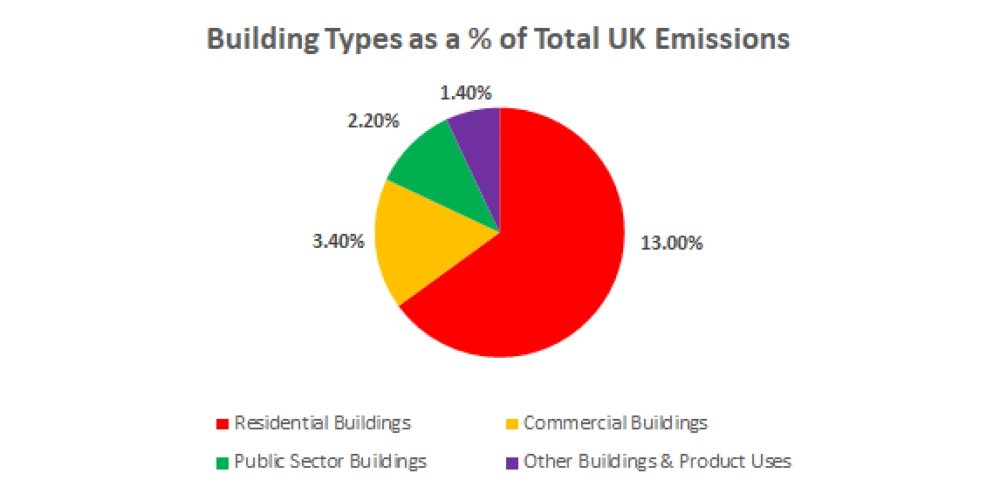
The potential to reduce building emissions through a focus on heat is significant - most of these emissions result from the combustion of fossil-fueled gas boiler systems. Our estate planning strategy considers how we can reduce consumption as quickly as possible, via either improving efficiency or system replacement. This involves further analysis and modelling of the wider environmental benefits, CAPEX and OPEX considerations.
Reduced Energy Consumption
UK Higher Education institutions collectively spend over £600m annually on natural gas and electricity (Ref: HESA). With many UK universities struggling with financial budgets, a reduction in energy consumption could mitigate the need for potential cuts to research, maintenance budgets or even educational resources and activities.
Energy reduction should be a core focus for all institutions. Activities to achieve this range from simple and quick interventions, such as control tweaks, to intensive, deep building retrofits. The UK Green Building Council divides this into three segments: optimisation, light retrofit and deep retrofit and highlights that the different levels of intervention have a different impact on a building’s energy intensity.
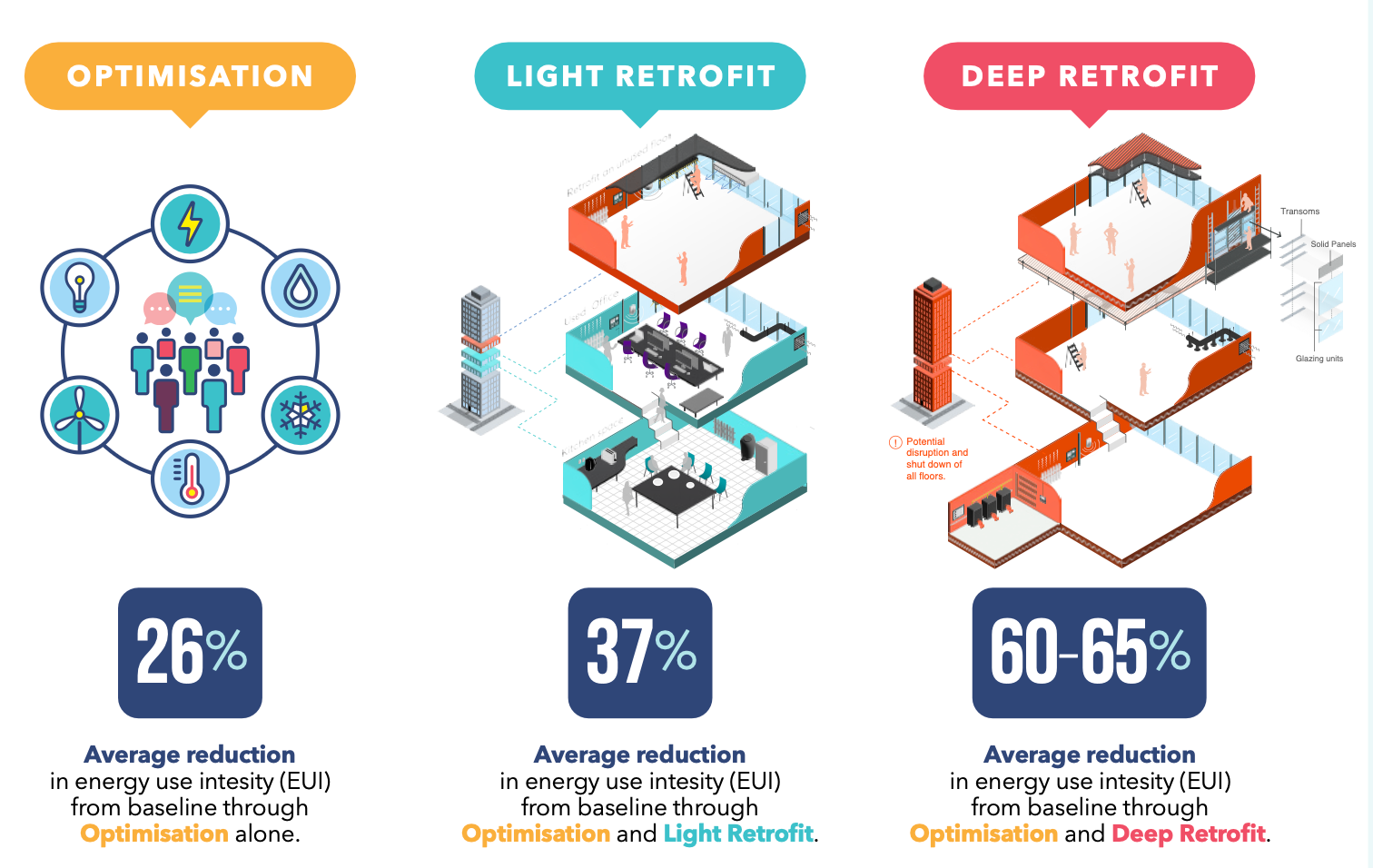
Without electrification of heating, a US-based project demonstrated the ability to reduce natural gas consumption by 70% in large office buildings (Ref: CBE). Although this reduction may not reflect the potential for other types of buildings, significant energy, carbon, and cost reductions are achievable without switching fuel source.
This project demonstrated deep reductions in the carbon intensity of natural gas space heating in existing large buildings in a scalable manner by focusing on deep efficiency measures — without replacing entire HVAC systems or performing a gut renovation. Through a combination of ‘Deep Decarbonization re-Design’ measures in two existing office buildings (120,000 and 110,000 ft²) annual gas consumption was reduced by 70%, plus substantial electricity savings. When combined, the measures reduced costs by $110,000 per year ($0.5/ft².yr) at current utility rates.
Priority is generally allocated on a financial basis, with interventions that will save energy and provide financial return undertaken as early as possible, to maximise environmental benefits and budget impacts.
This analysis does highlight that significant impacts can be delivered even when retaining fossil-fueled systems; whether as a bridge in advance of future system changes, or due to building or protected status challenges.
For the University of Cambridge, a key focus is ensuring systems are controlled effectively and are well-maintained. Existing Ground Source Heat Pump (GSHP) installations are a particular area of focus as a result of the high potential operating efficiency. Operational issues and inefficiencies in control can significantly increase energy consumption. Building Management Systems [BMS] and local sensors for control, which can integrate with the BMS, are core to the evolving focus on optimisation, monitoring and continuous improvement of energy efficiency best-practice.
Improved Occupant Comfort
We are mindful of updates and gains that can be achieved through building fabric itself, alongside physical equipment; consideration is given to the perception of building performance for the people utilising it. Individuals can be more comfortable in spaces with effective control, as this regulates a constant temperature through weather compensation analysis. An improvement in building air tightness through retrofit interventions can reduce draughts and make a space feel warmer in winter. Similarly, upgraded insulation makes occupants feel warmer by reducing the radiant cooling effect through cold surfaces such as walls and windows.
Within the University of Cambridge, the Entopia Building is the leading example of improving occupant comfort with an EnerPHit retrofit improving the building fabric; walls, windows, air tightness and roof, plus the mechanical ventilation and heating systems. Occupant comfort is also a key consideration when looking at replacing existing boiler systems, often with air source heat pumps. This transition needs to lower operating temperatures to maximise efficiency and often requires new pipework and heat emitters to ensure occupant comfort.
Specific project details on Entopia here.
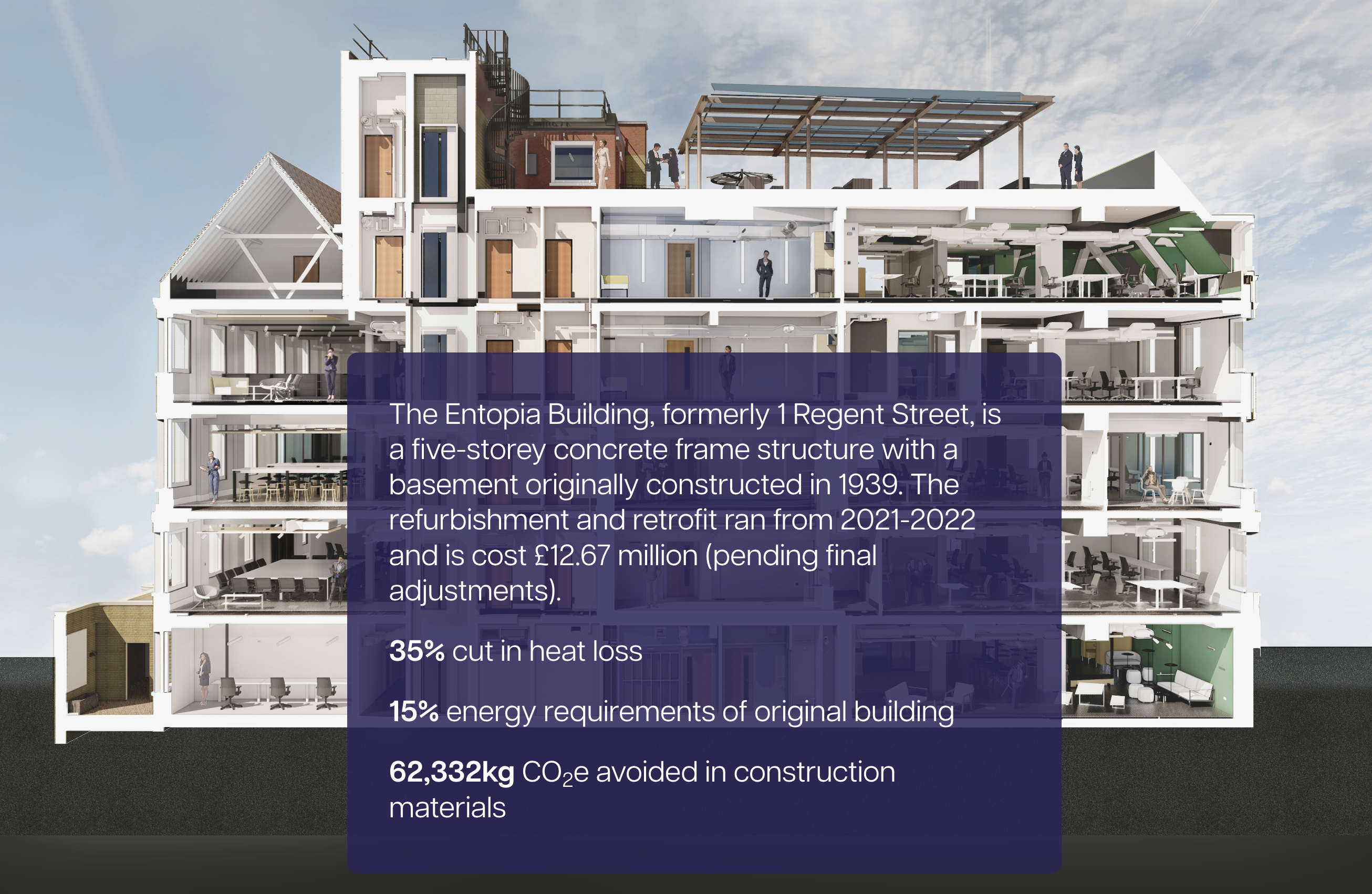
Trial and Adoption of Emerging Technologies
Academic institutions are uniquely placed to capitalise on emerging technologies. Innovation is an increasingly important part of the proposition to attract students to many universities and campuses can act as incubators of new technologies. This enables early access to new technologies before full commercialisation, creating opportunities for estate decarbonisation and for startups to build traction through real-world projects and data acquisition. Although trials are associated with greater risk, this can be mitigated through smaller-scale pilots, which are often enabled by grant funding.
A tension that the University of Cambridge has to balance is that many of the major energy-consuming buildings are critical research facilities, which cannot be compromised operationally. These buildings would be ideal candidates for trialling energy technology innovations; however, to ensure operational continuity, technologies must be validated elsewhere before installation. Therefore, typically, optimisation of existing systems is an effective starting point, in advance of any new technology implementation deployment, to avoid any potential operational compromise.
We can plan and manage the integration of any potential new technology pilots in less critical research facilities across the estate, as part of the wider strategy delivery.

Risks
Financial Sustainability
While sustainability is generally associated with the environment, the financial aspects are often overlooked. This is critical for university estates as they are asset-heavy organisations operating over a long-term horizon. For the decarbonisation of heating systems, there are two key areas relating to financial sustainability: the Spark Gap and the Performance Gap.
The Spark Gap relates to the difference in cost between electricity and natural gas. The cost of electricity in the UK is close to x4 times the cost of natural gas (Ref: NESTA). The high cost of electricity is exacerbated by the levies, both historical and current, that the UK Government applies to electricity bills to fund initiatives such as renewable energy and home insulation. Levies placed on electricity are approximately x3 times the amount of levies on gas. These levies make the cost of electricity relative to gas significantly higher than in European countries.
The Performance Gap is the difference between the actual operating performance of a system and the theoretical performance when designed. For example, an Air Source Heat Pump (ASHP) system may be designed with a coefficient of performance of 3.5, which is equivalent to an efficiency of 350%. In operation, the same ASHP system may operate at a coefficient of performance of 2.5 if the system is not correctly designed and managed.
Gas boiler systems always deliver <100% / <1 COP efficiency by comparison.
The weighting and imbalance between all these considerations - levies, operational performance, Spark Gap - creates significant operational cost barriers to heat decarbonisation. There are always opportunities to extend the Performance Gap, which can assist the financial sustainability, especially once the optimisation takes efficiency of electric-based systems to even higher COP. Some GSHP and Geothermal systems can reach a COP of 5.
Lobbying the UK Government to adjust the levies and align their policies with their desire to decarbonise the UK economy will assist in narrowing the Spark Gap. The Review of Electricity Market Arrangements (Ref: REMA) is working through the Spark Gap challenges and how the cost of electricity is delivered to the market.
The major impact of the spark gap is the speed of the heat decarbonisation transition. As the business case for operational expenditure is negatively impacted, this can inhibit or delay the progression of heat decarbonisation projects. Without a narrowing of the Spark Gap, a greater energy expenditure when electrifying heat must be forecasted and planned for. This emphasises the need for Demand Side Reduction strategies to maintain financial sustainability.
Electrical Infrastructure
A further barrier to the decarbonisation of heat is the electrical infrastructure that hosts our planned electric equipment, such as heat pumps. We are reliant on the availability of electrical capacity in the local and regional network. For smaller projects, this could lead to a transformer upgrade, and for larger projects, this could lead to major grid infrastructure upgrades. The cost of electrical infrastructure upgrades can be prohibitive, and in addition to cost, there can be further implications for projects through programme and planning.
Collaboration with District Network Operators (DNOs) is increasingly important, and for large estates such as the University of Cambridge, this engagement is a critical part of long-term infrastructure planning and continuity. Thankfully, DNOs are increasingly proactive in looking at long-term planning and innovation, making this collaboration better aligned as all key stakeholders work towards electrification. On an individual project basis, where electrical upgrades are required, the cost and programme implications are similarly important when replacing end-of-life equipment and major system changes, to prevent any downtime as a result of programme extensions.
Replacement Cycles
When assessing heat decarbonisation, replacement cycles are important to be aware of, particularly when planning for the long term. Gas boilers have an expected lifespan of 20 years, and heat pumps have an expected lifespan of 15 years (Ref: CIBSE Guide M document). This leads to a shorter replacement cycle for systems, subject to manufacturers' own performance and warranty expectations, water quality, and system operation and maintenance.

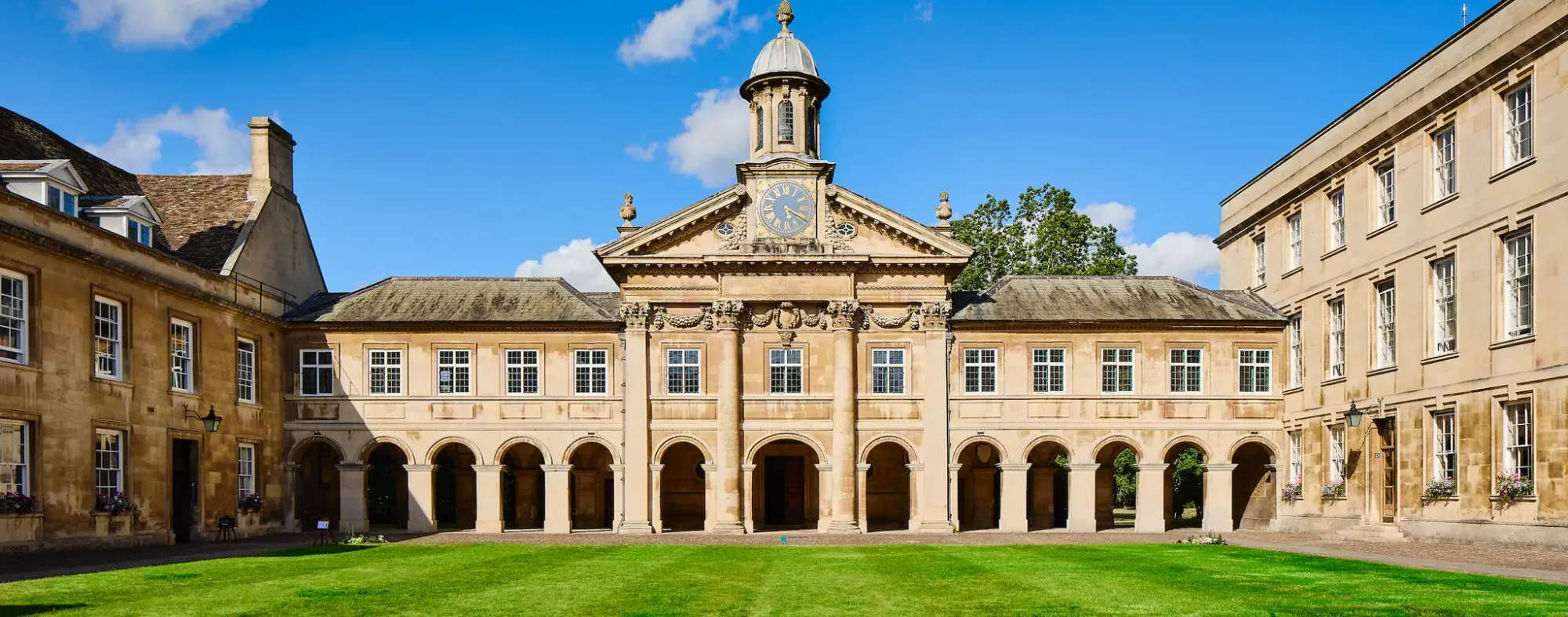

Image Credit: University of Cambridge, Various Locations
Internal Support and Collaboration
Larger university estates are fortunate to have a wealth of expertise to draw upon within the estates department. This can enable the completion of initial assessments or feasibility reports internally with minimal external involvement or cost.
Many building managers and academics have a passion for sustainability, which can enable knowledge sharing and collaboration. This is also an opportunity to gain feedback to assist where there may be a lack of data to inform objective decision-making.
When we combine this with the opportunities provided by technology innovation and research inputs, we can leverage internal knowledge and skills to help deliver effective estate decarbonisation and foster collective engagement in the process. Across large multi-site locations, this engagement, communication and data sharing between teams also ensures alignment on planned maintenance, programme management and major retrofits.
The University of Cambridge is increasing the focus on asset and maintenance data, creating more opportunities for cross-functional collaboration and evolving processes to capitalise on internal knowledge and expertise.
Summary
The complexities and challenges around decarbonising such a large, historically important and protected estate are many. Combine this with advanced laboratory facilities, new building construction and a large student and staff head count, and it's easy to see how every building, project or system update has to be carefully considered and specified.
As we progress our decarbonisation strategy, we are fortunate to access knowledgeable internal resources with options to implement new technologies and energy sector research.
We continue to move forward with a commitment to rapidly decarbonise our estate to meet Net Zero objectives, and despite some of our buildings being 800 years old, we are well on our way.
For further reading on the University of Cambridge's sustainability activities, see their environmental sustainability page.
About the Author
Stephen Graham
Decarbonisation Project Leader for the University of Cambridge Estates team, Stephen brings 5 years of built environment and mechanical engineering consulting experience with Hoare Lea.
Stephen is a Chartered Mechanical Engineer CEng, he previously secured his MEng in Mechanical Engineering at Heriot-Watt University and is currently concluding an MBA in Business Administration at Imperial College
You can follow Stephen on LinkedIn:
Stephen Graham - Decarbonising University Estates








